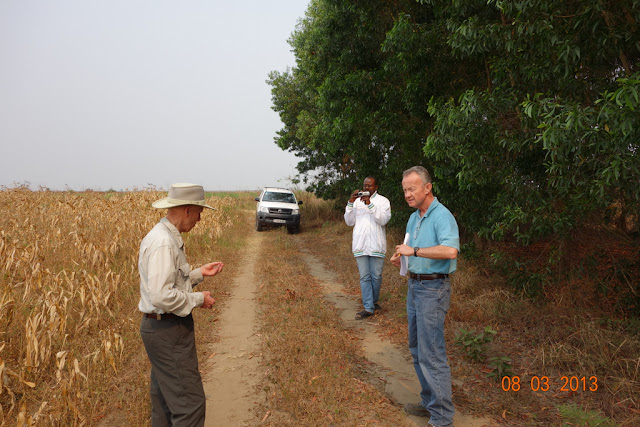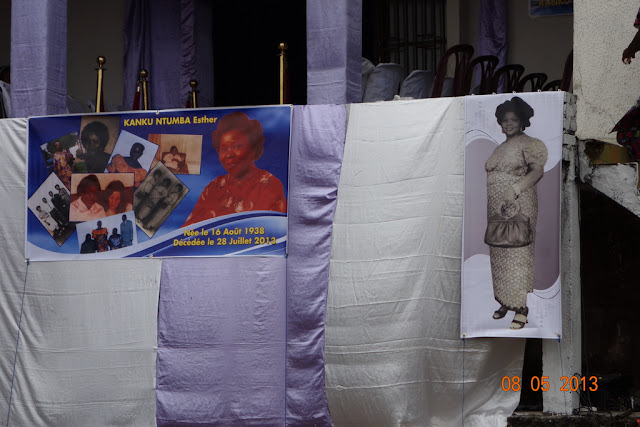 |
Black River on the way to the farm on the Bateke Plateau. The bottom is black stone, but the water is very clear. It could play an important role in hydroelectric generation for farm development. |
 |
The bridge across the Black River. A youth dressed for a swim. Women have hung recently washed clothes to dry. |
 |
Serge, the owner of the farm, and member of the Church, when he flagged us down after missing the turn. |
 |
Tree trimming. It was too close to the small-animal building where they raised chickens in the past. |
 |
Timberrrr.... |
 |
Serge and his wonderful family by a small spring-fed lake at the edge of his property. |
 |
We were there. |
 |
Kids were fishing at the lake--their catch. |
 |
Entrance to a small nunnery inhabited by four nuns living in quarters made from shipping containers. They have oil and coconut palms on their farm. |
 |
Through the windshield. These are empty, but many long-haul vehicles carry their fuel with them in "bidons" like these, or they transport for sale in remote villages. Watch out in a wreck. |
 |
This shirt, one of only two casual shirts that I brought, ripped in the back--too old and well worn. I am looking for another. |
 |
Helping hands carrying sand bags to fill in an eroded path in the village. |
 |
Filling and sewing the sand bags shut. |
 |
Path to be covered by the sand bags. |
 |
A Bishop being interviewed about the Helping Hands project. |
 |
Helping Hands participants at a medical center. |
 |
Nunnery housing enclosure with a lovely little flower garden within. |
 |
Signs at the Farm entrance. |
 |
Visiting a spring on the farm with Serge and his family, and an employee. |
 |
Cage monkey on the nunnery grounds. There were three of them in separate cages. |
 |
The fisherman. |
 |
The spring. |
 |
Buildings housing guest rooms, conference space, and a lounge and kitchen. |
 |
Sue and the other wives helped decorate for a Stake Relief Society event. Husbands helped a bit too. |
 |
View of a previous year's sand bag project to stabilize a path into the village. |
 |
Maternity Center cleaning project. |
 |
Delivery room. |
 |
Reception area. |
 |
Flowers on a tree in the garden around the building housing the Mission Home. They bloom white and shades of purple. |
 |
Mimosa bloom. |
 |
Corn field ready to hand harvest. The corn will be ground into flour for fu fu, or other culinary dishes. |
 |
In the road between corn and Acacia stands. |
 |
Field corn ear. |
 |
Spring fed lake that may be useful for irrigation. |
 |
Water lily in the lake. |
 |
Cat fish ready for the barby. |
 |
Checking out the soil profile in an excavation made for road fill. |
 |
A marsh stays wet during the dry season and may be excavated to produce a lake similar to the other one. |
 |
Amaranth gone to seed. Here in Congo the foliage is eaten not the seeds. This one has gone to seed and may be used to plant another crop. |
 |
Tenant farmers learning to produce crops for market. |
 |
The raised beds are hand watered. Very labor intensive. |
 |
This mushroom shaped termite mound was collected by one of the tenant farmers. He will take it home, break it open in the chicken coop for a treat for the hens. |
 |
A termite mound in the midst of a burned over field. |
 |
The farm covers over 4,000 acres. |
 |
View down the hall on the top floor of the chapel in Massina. |
 |
Hall in the tall chapel in the other direction. |
 |
Setting up chairs for Priesthood. |
 |
View from the window over Massina from the top floor of the Chapel. |
 |
Parking lot outside of the chapel. They also have parking on the ground floor. |
 |
Waiting for the vehicles to load and the procession to the home. |
 |
Purple decorates the entrance, the balcony, and the large reception room inside the home where mourners gather in chairs encircling the room. |
 |
The casket is carried up the flanking stair case into the viewing area. Tents and chairs, about 200, flank the yard and two speaker towers play loud music in Lingala and French. |
 |
Photos illustrating the deceased's life. |
 |
A time for sharing grief. |










No comments:
Post a Comment